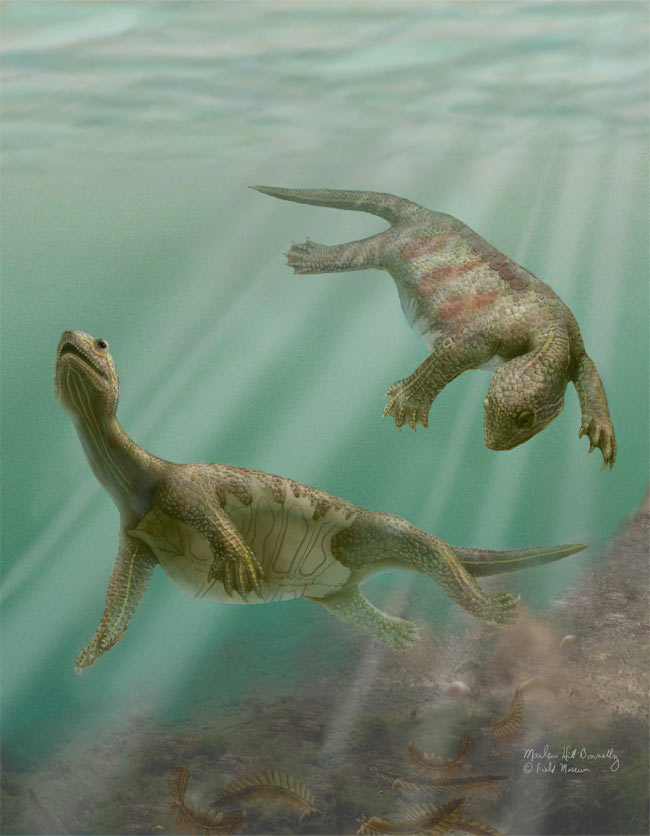First Known Turtle Had Shell Shortcomings

A half-shell turtle species that swam in China's coastal waters 220 million years ago is the oldest turtle known to date, a new analysis of fossils reveals.
The turtle had a belly shell, but its back was basically bare of armor.
Last week, a team of scientists had reported the discovery of the oldest aquatic turtle, dating back 164 million years. That was a short-lived title. The new half-shell aquatic turtle, studied by Chun Li of the Chinese Academy of Sciences in Beijing and his colleagues and dubbed Odontochelys semistestacea, swam around even longer ago.
Li and his team looked at remains that included two skulls and other skeletal bones unearthed in China's Guizhou province in 2007. The analysis, detailed in the Nov. 27 issue of the journal Nature, suggests that today's turtles must have originated from an aquatic-turtle ancestor. The results also provide support for a theory of how turtle shells evolved.
Shells start at belly
The specimens studied by Li showed many signs of being from primitive turtles. For instance, the researchers found Odontochelys had an elongated, pointed snout. Most modern turtles have short snouts. In addition, the roof of its mouth, along with the upper and lower jaws, were equipped with teeth, which the researchers say is a primitive feature for turtles whose mugs are now tipped with beaks but contain no teeth.
The fact that the turtle had a partial shell (only covering its belly) sheds light on an intermediate stage of shell evolution that scientists hadn't seen. Before the discovery of Odontochelys, the oldest known turtle species (aquatic or land-based) was the terrestrial turtle Proganochelys, which lived about 210 million years ago. But this turtle had a fully formed shell, providing little evidence as to how the shell evolved.
Get the world’s most fascinating discoveries delivered straight to your inbox.
One idea has been that the turtle shell evolved from bony plates on the skin that broadened and fused together to form the turtle's armor. The entire structure would then fuse to the underlying ribs and backbone. (Modern reptiles, such as crocodiles, have these bony plates, as did some dinosaurs, such as ankylosaurs.)
The newly studied Odontochelys specimens, however, showed no signs of bony skin plates. Instead, they had broad ribs and a belly shell extending from the backbones. These features point to another mode of shell evolution in which the belly shell evolved first. Then, the ribs and backbone broadened to form the upper shell, the researchers said.
Ancient turtle lived in water
Lending further support, this evolution tale matches shell development in modern-day turtle embryos in which the backbones expand outward and the ribs broaden to meet and form a shell.
The complete shell on the new fossil's underside also suggests the turtles lived in the water, where their bellies would be exposed to predators. "Reptiles living on the land have their bellies close to the ground with little exposure to danger," said researcher Olivier Rieppel, a geologist at The Field Museum in Chicago.
In an accompanying Nature article, researchers point to an alternative hypothesis for this partially-protected turtle. They suggest even earlier turtles donned a complete upper and lower shell, but this turtle had a reduced upper shell, one that wasn't hardened as bone, as an adaptation for living in the water.
Rieppel disagreed, telling LiveScience that if the turtle had once carried a complete shell, the researchers would have noticed other changes in the turtle's ribs and vertebrae. They didn't see these changes.
The research was funded by the Ministry of Science and Technology of China, National Natural Science Foundation of China, Chinese Academy of Sciences and Canadian Museum of Nature.
- Do All Turtles Have Shells?
- Rumor or Reality: The Creatures of Cryptozoology
- Images: Dinosaur Fossils
Jeanna Bryner is managing editor of Scientific American. Previously she was editor in chief of Live Science and, prior to that, an editor at Scholastic's Science World magazine. Bryner has an English degree from Salisbury University, a master's degree in biogeochemistry and environmental sciences from the University of Maryland and a graduate science journalism degree from New York University. She has worked as a biologist in Florida, where she monitored wetlands and did field surveys for endangered species, including the gorgeous Florida Scrub Jay. She also received an ocean sciences journalism fellowship from the Woods Hole Oceanographic Institution. She is a firm believer that science is for everyone and that just about everything can be viewed through the lens of science.


